Jiang Zhang
Spring
Optimizing Recall or Relevance? A Multi-Task Multi-Head Approach for Item-to-Item Retrieval in Recommendation
Jun 06, 2025Abstract:The task of item-to-item (I2I) retrieval is to identify a set of relevant and highly engaging items based on a given trigger item. It is a crucial component in modern recommendation systems, where users' previously engaged items serve as trigger items to retrieve relevant content for future engagement. However, existing I2I retrieval models in industry are primarily built on co-engagement data and optimized using the recall measure, which overly emphasizes co-engagement patterns while failing to capture semantic relevance. This often leads to overfitting short-term co-engagement trends at the expense of long-term benefits such as discovering novel interests and promoting content diversity. To address this challenge, we propose MTMH, a Multi-Task and Multi-Head I2I retrieval model that achieves both high recall and semantic relevance. Our model consists of two key components: 1) a multi-task learning loss for formally optimizing the trade-off between recall and semantic relevance, and 2) a multi-head I2I retrieval architecture for retrieving both highly co-engaged and semantically relevant items. We evaluate MTMH using proprietary data from a commercial platform serving billions of users and demonstrate that it can improve recall by up to 14.4% and semantic relevance by up to 56.6% compared with prior state-of-the-art models. We also conduct live experiments to verify that MTMH can enhance both short-term consumption metrics and long-term user-experience-related metrics. Our work provides a principled approach for jointly optimizing I2I recall and semantic relevance, which has significant implications for improving the overall performance of recommendation systems.
PCDCNet: A Surrogate Model for Air Quality Forecasting with Physical-Chemical Dynamics and Constraints
May 26, 2025Abstract:Air quality forecasting (AQF) is critical for public health and environmental management, yet remains challenging due to the complex interplay of emissions, meteorology, and chemical transformations. Traditional numerical models, such as CMAQ and WRF-Chem, provide physically grounded simulations but are computationally expensive and rely on uncertain emission inventories. Deep learning models, while computationally efficient, often struggle with generalization due to their lack of physical constraints. To bridge this gap, we propose PCDCNet, a surrogate model that integrates numerical modeling principles with deep learning. PCDCNet explicitly incorporates emissions, meteorological influences, and domain-informed constraints to model pollutant formation, transport, and dissipation. By combining graph-based spatial transport modeling, recurrent structures for temporal accumulation, and representation enhancement for local interactions, PCDCNet achieves state-of-the-art (SOTA) performance in 72-hour station-level PM2.5 and O3 forecasting while significantly reducing computational costs. Furthermore, our model is deployed in an online platform, providing free, real-time air quality forecasts, demonstrating its scalability and societal impact. By aligning deep learning with physical consistency, PCDCNet offers a practical and interpretable solution for AQF, enabling informed decision-making for both personal and regulatory applications.
Preserving Privacy and Utility in LLM-Based Product Recommendations
May 02, 2025Abstract:Large Language Model (LLM)-based recommendation systems leverage powerful language models to generate personalized suggestions by processing user interactions and preferences. Unlike traditional recommendation systems that rely on structured data and collaborative filtering, LLM-based models process textual and contextual information, often using cloud-based infrastructure. This raises privacy concerns, as user data is transmitted to remote servers, increasing the risk of exposure and reducing control over personal information. To address this, we propose a hybrid privacy-preserving recommendation framework which separates sensitive from nonsensitive data and only shares the latter with the cloud to harness LLM-powered recommendations. To restore lost recommendations related to obfuscated sensitive data, we design a de-obfuscation module that reconstructs sensitive recommendations locally. Experiments on real-world e-commerce datasets show that our framework achieves almost the same recommendation utility with a system which shares all data with an LLM, while preserving privacy to a large extend. Compared to obfuscation-only techniques, our approach improves HR@10 scores and category distribution alignment, offering a better balance between privacy and recommendation quality. Furthermore, our method runs efficiently on consumer-grade hardware, making privacy-aware LLM-based recommendation systems practical for real-world use.
SpinML: Customized Synthetic Data Generation for Private Training of Specialized ML Models
Mar 05, 2025Abstract:Specialized machine learning (ML) models tailored to users needs and requests are increasingly being deployed on smart devices with cameras, to provide personalized intelligent services taking advantage of camera data. However, two primary challenges hinder the training of such models: the lack of publicly available labeled data suitable for specialized tasks and the inaccessibility of labeled private data due to concerns about user privacy. To address these challenges, we propose a novel system SpinML, where the server generates customized Synthetic image data to Privately traIN a specialized ML model tailored to the user request, with the usage of only a few sanitized reference images from the user. SpinML offers users fine-grained, object-level control over the reference images, which allows user to trade between the privacy and utility of the generated synthetic data according to their privacy preferences. Through experiments on three specialized model training tasks, we demonstrate that our proposed system can enhance the performance of specialized models without compromising users privacy preferences.
Predicting Company Growth by Econophysics informed Machine Learning
Oct 23, 2024Abstract:Predicting company growth is crucial for strategic adjustment, operational decision-making, risk assessment, and loan eligibility reviews. Traditional models for company growth often focus too much on theory, overlooking practical forecasting, or they rely solely on time series forecasting techniques, ignoring interpretability and the inherent mechanisms of company growth. In this paper, we propose a machine learning-based prediction framework that incorporates an econophysics model for company growth. Our model captures both the intrinsic growth mechanisms of companies led by scaling laws and the fluctuations influenced by random factors and individual decisions, demonstrating superior predictive performance compared with methods that use time series techniques alone. Its advantages are more pronounced in long-range prediction tasks. By explicitly modeling the baseline growth and volatility components, our model is more interpretable.
Efficient Toxic Content Detection by Bootstrapping and Distilling Large Language Models
Dec 13, 2023Abstract:Toxic content detection is crucial for online services to remove inappropriate content that violates community standards. To automate the detection process, prior works have proposed varieties of machine learning (ML) approaches to train Language Models (LMs) for toxic content detection. However, both their accuracy and transferability across datasets are limited. Recently, Large Language Models (LLMs) have shown promise in toxic content detection due to their superior zero-shot and few-shot in-context learning ability as well as broad transferability on ML tasks. However, efficiently designing prompts for LLMs remains challenging. Moreover, the high run-time cost of LLMs may hinder their deployments in production. To address these challenges, in this work, we propose BD-LLM, a novel and efficient approach to Bootstrapping and Distilling LLMs for toxic content detection. Specifically, we design a novel prompting method named Decision-Tree-of-Thought (DToT) to bootstrap LLMs' detection performance and extract high-quality rationales. DToT can automatically select more fine-grained context to re-prompt LLMs when their responses lack confidence. Additionally, we use the rationales extracted via DToT to fine-tune student LMs. Our experimental results on various datasets demonstrate that DToT can improve the accuracy of LLMs by up to 4.6%. Furthermore, student LMs fine-tuned with rationales extracted via DToT outperform baselines on all datasets with up to 16.9\% accuracy improvement, while being more than 60x smaller than conventional LLMs. Finally, we observe that student LMs fine-tuned with rationales exhibit better cross-dataset transferability.
Neural Network Pruning by Gradient Descent
Nov 22, 2023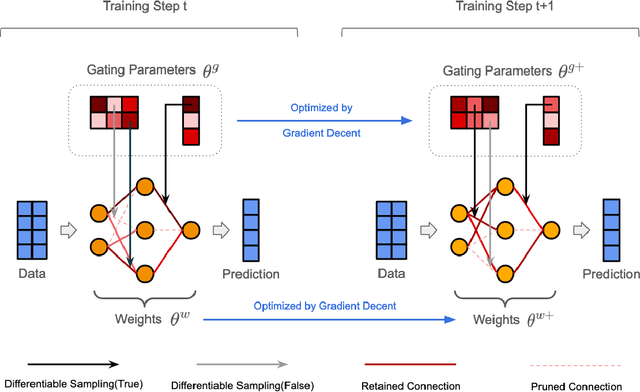
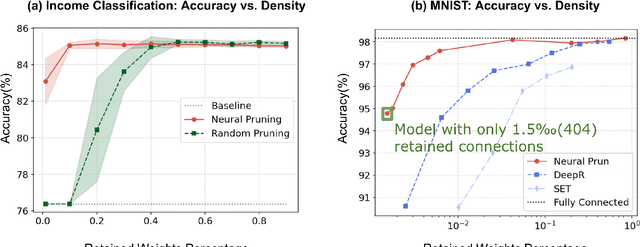
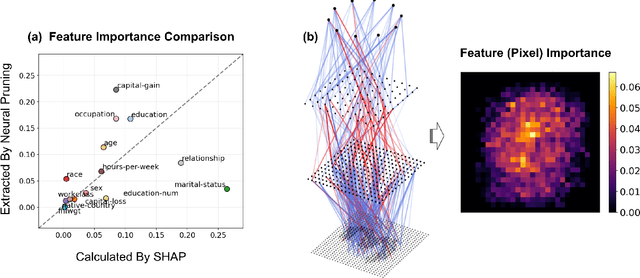
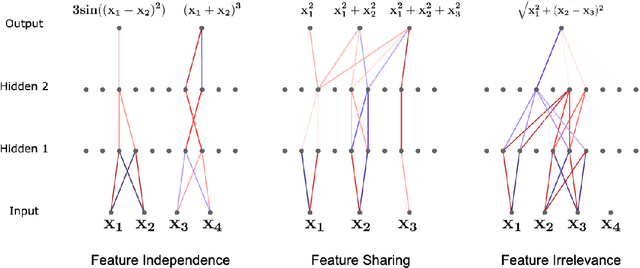
Abstract:The rapid increase in the parameters of deep learning models has led to significant costs, challenging computational efficiency and model interpretability. In this paper, we introduce a novel and straightforward neural network pruning framework that incorporates the Gumbel-Softmax technique. This framework enables the simultaneous optimization of a network's weights and topology in an end-to-end process using stochastic gradient descent. Empirical results demonstrate its exceptional compression capability, maintaining high accuracy on the MNIST dataset with only 0.15\% of the original network parameters. Moreover, our framework enhances neural network interpretability, not only by allowing easy extraction of feature importance directly from the pruned network but also by enabling visualization of feature symmetry and the pathways of information propagation from features to outcomes. Although the pruning strategy is learned through deep learning, it is surprisingly intuitive and understandable, focusing on selecting key representative features and exploiting data patterns to achieve extreme sparse pruning. We believe our method opens a promising new avenue for deep learning pruning and the creation of interpretable machine learning systems.
Data driven modeling of self-similar dynamics
Oct 27, 2023



Abstract:Multiscale modeling of complex systems is crucial for understanding their intricacies. Data-driven multiscale modeling has emerged as a promising approach to tackle challenges associated with complex systems. On the other hand, self-similarity is prevalent in complex systems, hinting that large-scale complex systems can be modeled at a reduced cost. In this paper, we introduce a multiscale neural network framework that incorporates self-similarity as prior knowledge, facilitating the modeling of self-similar dynamical systems. For deterministic dynamics, our framework can discern whether the dynamics are self-similar. For uncertain dynamics, it can compare and determine which parameter set is closer to self-similarity. The framework allows us to extract scale-invariant kernels from the dynamics for modeling at any scale. Moreover, our method can identify the power law exponents in self-similar systems. Preliminary tests on the Ising model yielded critical exponents consistent with theoretical expectations, providing valuable insights for addressing critical phase transitions in non-equilibrium systems.
Finding emergence in data: causal emergence inspired dynamics learning
Aug 19, 2023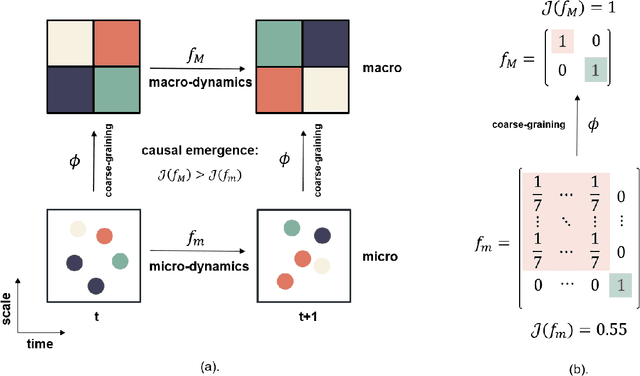
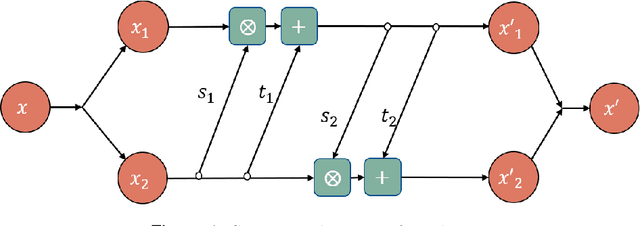

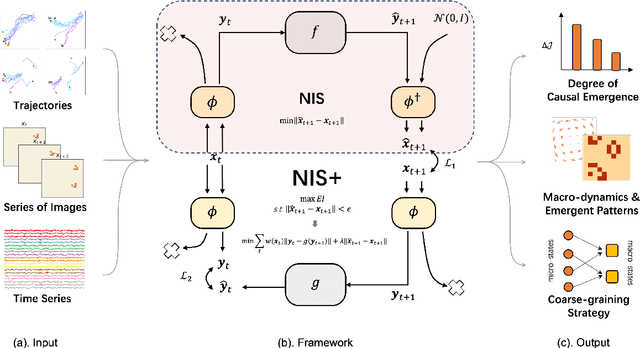
Abstract:Modelling complex dynamical systems in a data-driven manner is challenging due to the presence of emergent behaviors and properties that cannot be directly captured by micro-level observational data. Therefore, it is crucial to develop a model that can effectively capture emergent dynamics at the macro-level and quantify emergence based on the available data. Drawing inspiration from the theory of causal emergence, this paper introduces a machine learning framework aimed at learning macro-dynamics within an emergent latent space. The framework achieves this by maximizing the effective information (EI) to obtain a macro-dynamics model with stronger causal effects. Experimental results on both simulated and real data demonstrate the effectiveness of the proposed framework. Not only does it successfully capture emergent patterns, but it also learns the coarse-graining strategy and quantifies the degree of causal emergence in the data. Furthermore, experiments conducted on environments different from the training dataset highlight the superior generalization ability of our model.
Dynamic Graph Neural Network with Adaptive Edge Attributes for Air Quality Predictions
Feb 20, 2023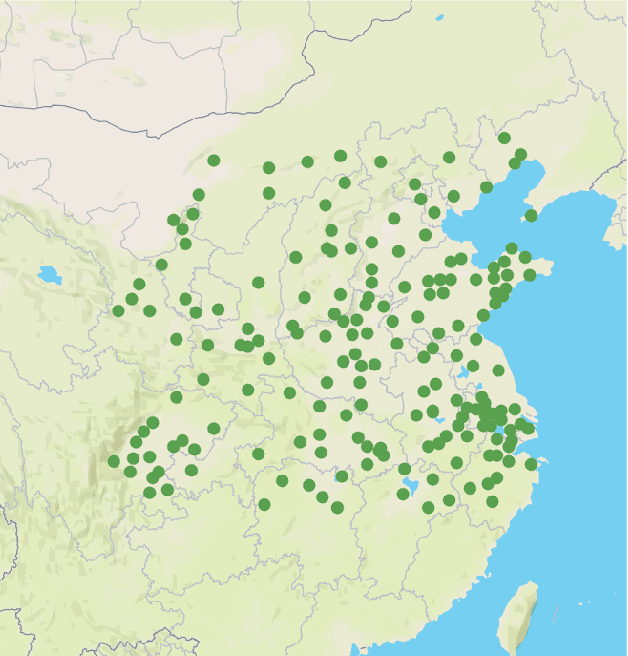
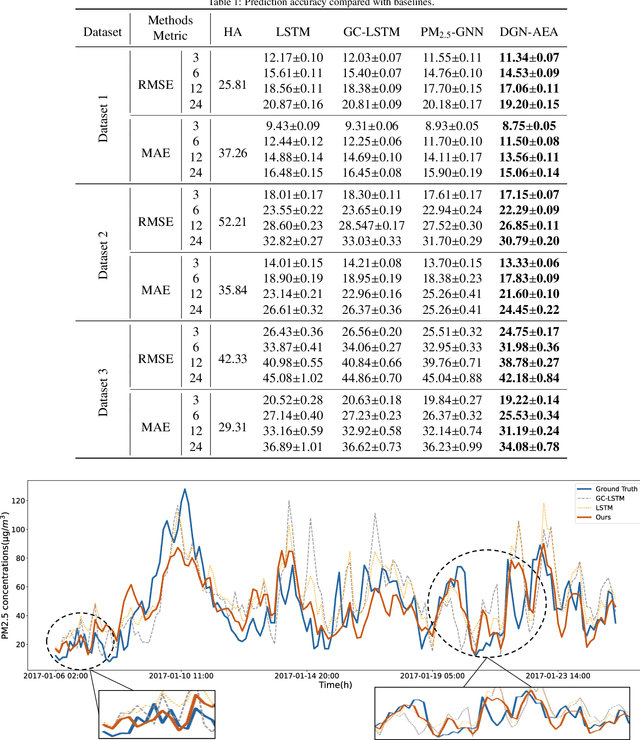
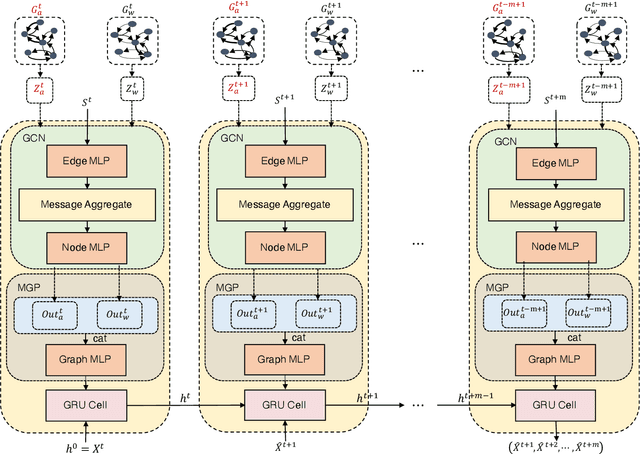
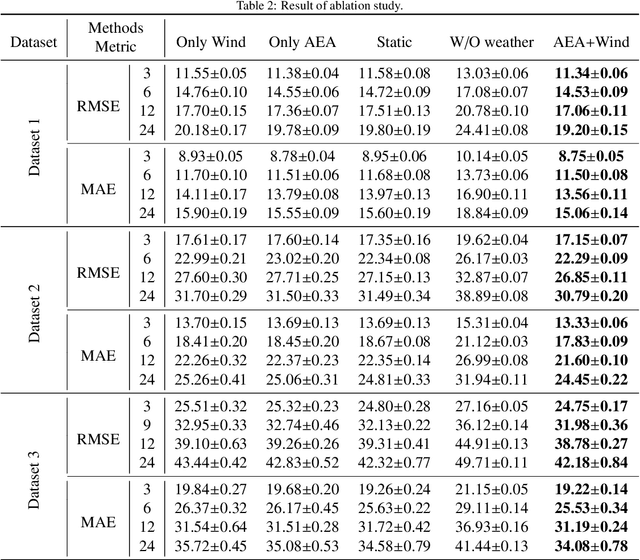
Abstract:Air quality prediction is a typical spatio-temporal modeling problem, which always uses different components to handle spatial and temporal dependencies in complex systems separately. Previous models based on time series analysis and Recurrent Neural Network (RNN) methods have only modeled time series while ignoring spatial information. Previous GCNs-based methods usually require providing spatial correlation graph structure of observation sites in advance. The correlations among these sites and their strengths are usually calculated using prior information. However, due to the limitations of human cognition, limited prior information cannot reflect the real station-related structure or bring more effective information for accurate prediction. To this end, we propose a novel Dynamic Graph Neural Network with Adaptive Edge Attributes (DGN-AEA) on the message passing network, which generates the adaptive bidirected dynamic graph by learning the edge attributes as model parameters. Unlike prior information to establish edges, our method can obtain adaptive edge information through end-to-end training without any prior information. Thus reduced the complexity of the problem. Besides, the hidden structural information between the stations can be obtained as model by-products, which can help make some subsequent decision-making analyses. Experimental results show that our model received state-of-the-art performance than other baselines.
 Add to Chrome
Add to Chrome Add to Firefox
Add to Firefox Add to Edge
Add to Edge